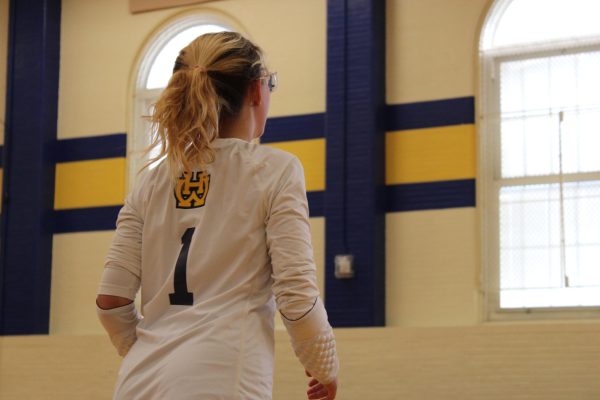Exemplary students: how middle school affects girls
According to the National Federation of State High School Association, “Middle school children who have phones, especially girls, are more prone to emotional and behavioral issues later in adolescence. Most experts recommend that children in this age group not have access to social media because of increased chance in cyberbullying.” The pandemic has caused waves in girl’s mental health and academic pressure as they navigate through WHHS.
Middle school is where you discover yourself, but the process can be harder on some more than others. With girls, it’s the expectation on how they should act, the standards of academics and the pressure from society that wants to dictate their every move.
Middle school is where self-esteem starts, students enter the building without knowing anyone. This creates pressure to try to fit in especially at this age of adolescents. Becky Junewick, a seventh to ninth grade counselor at WHHS notes, “Adolescent brains are wired to care more about what their friends think than what adults think,” she said. This can create the desire to be liked by peers and can create pressure to try to fit in as much as possible.
“I would say especially at WHHS coming in as a seventh-grader I feel like, yes there is a lot of pressure because you’re in a school with high school students coming in as a seventh-grader it can be overwhelming because you’re in a school with someone who may be seventeen or eighteen years old,” Daryan Martin said.
Finding friends can be like finding a part of yourself. As old elementary friends drift away, middle schoolers are forced to find new people with similar interests and in doing so, cliques start to form. Cliques are often viewed in the media as exclusively female and only offer cattiness.
“Guys really all blend together. You have your athlete, your nerds, but even then they often overlap for the male gender. But with females I feel like it’s very strict. You’re this or that,” Layla Owliaie, ‘25, said.
There is overwhelming pressure for girls to figure out what group they belong in when they are already judged for their interests. Things that are targeted to a female audience are seen as immature and are disparaged by the media and critics alike. Instead of accepting it for what it is, people devote hate towards girl centerted entertainment creating the idea that their beliefs and opinions are immature or not good enough in society. Females have to prove their own interests in male centered spaces such as gaming and sports as well.
“I hate when people judge a girl for their interests. Any interests like how they dress, and they could dress any way and they’ll always judge them. If they wear too much makeup they’ll think they are fake,” Izzy Chiong, ‘26 said
The need to belong changes how people act in certain scenarios. They may not try to be their true selves if they are around certain social groups. Girls are often pressured by older girls to grow up more quickly and despite the uncertainty of identity in adolescent girls they are expected to know what they want to be.
There is the idea of perfectionism with academics that puts pressure on girls as well. In a new, different environment with more teachers and more homework they are expected to manage themselves. There are high expectations to meet at WHHS and the change in workload expectations can create immense pressure to build grades up that goes back to elementary school years.
“A lot of young ladies that I speak to, and I guess they are getting it from their moms and families, come in with an A, B, C, D plan in terms of what they want to do. ‘I want to be a lawyer, a doctor, and own my own business.’ The ambition and drive seem to be instilled in young ladies at an earlier age than it is for young men,” William Harris, a seven to ninth grade student counselor, said.
Despite this, research by University of Chicago and Stanford University finds that parents are more likely to give praise to boys because of their effort than girls, creating a mindset that their failure around intelligence is inability. At the same time socially girls are expected to be more mature for their age and focus on school work and life goals instead of just being kids. This maturity translates into academics as well.
“People assume that a girl is perfect and their grades should reflect that too,” Chiong said.
As cited by Open Educational Resources: Educational Psychology, teachers are more likely to praise a boy for presenting the information correctly and are more likely to criticize a girl for presenting the incorrect information. This lack of positive feedback can lead to girls feeling less confident in their academic ability reinforcing the idea of perfectionism.
Girls are supposed to act well behaved and attentive so asking for help is seen as an imperfection from society’s point of view. The fear of failure can lead to anxiety. According to Plan International, girls often suppress their emotions with the worry of seeming hysterical or dramatic. They are told to keep their emotions in check with the worry of not being taken seriously and are expected to be nurturing which leads to girls putting others feelings above their own.
Eniola Olakanmi, ‘26, said, “They don’t care about how we feel they just want you to do something that will please everyone else but they won’t care if you really want to do it or not.”
There is also a lack of control with online learning that has thrown many people off course.
Grace Barnes, ‘26, said, “I’m very social so not being around many people is hard.” Barnes describes it as her current source of stress.
According to non-profit website Understood, being in quarantine disrupts the important developmental social stage in seventh to ninth grade. This isolation leads to mental health disorders like anxiety and depression. The Child Mind Institute notes that, “Adolescent girls are more than twice as likely to experience depression than boys.”
The pandemic has shifted the intensity of underlining obstacles already in girl’s mental health.
“Getting over their feelings and emotional concerns [is the biggest concern right now],” Harris said, “They hold it in until sometimes it just breaks. It didn’t just start yesterday… Yes, the pandemic exacerbated their feelings of low self-worth, lack of social acceptance…They don’t talk about it on the onset so that it can’t be compound until they have an episode and it’s exposed. For me it’s helping society, not just young people. Young people get their thoughts from society and adults, removing those stigmas around mental health.”
Mental health is often brushed to the side as a non immediate problem because it’s not a visible illness that people can treat.
Owliaie believes that the biggest problem in girls mental health is that it’s not taken seriously among younger girls, “During middle school or high school if you try to talk to your parents or your friends and say ‘I’m feeling really depressed’ or ‘my anxiety is really skyrocketing right now’ people just assume you’re trying to be quirky or ‘I’m not like other girls.’ Once you’re in college or seniorish people are like ‘she’s not actually okay she’s not pretending for the drama or the popularity. She actually does need a little bit of help. She actually is feeling this way.’”
There is a lack of self esteem that young middle school girls have as their body is changing. They feel uncomfortable with themselves and are expected to look like an airbrushed model leading to an exorbitant amount of effort put into social media.
Junewick said, “One thing I see is the expectation of perfection specifically to what it pertains to what we see on social media. I’ve read some research on girls and how they will take 80 pictures for every one that they post. It takes them 80 tries to get to a picture they are most comfortable with. Which I think is a bit sad because seventy out of the eighty of those were perfectly acceptable. It’s just that perfectionism and the idea to be perfect.”
The idea of perfectionism is also rooted in models girls see passing the store. Girls often find themselves compared to an unattainable beauty image and holding themselves to that standard. This makes social media a disaster with many joining by age 11.
According to the Children Resource Group in Middle School Girls; Self-Esteem and Academic Issues, middle school girls are more likely to deal with the stress of social media differently than boys. “The amygdala, a part of the brain that handles emotional stimuli, matures faster in girls than in boys. This causes girls to react more strongly to stress and attach emotional memories to negative events.”
This makes the stress of trying to keep up to a standard of beauty difficult. Cosmetic companies target this insecurity of trying to look like others as well as trying to mature faster into a young woman.
Barnes said the idea of being forced to look a certain way to attain a beauty ideal is rooted in social media. “I definitely think like insecurities and trying to fit in essentially ‘I need to be this way and I have to be this way’,” she said.
So what should be done about the immense social pressure on academics, mental health and social media? Just by being your own individual you break the mold and help create a better environment for future girls.
“When you start to think ‘do I really belong at Walnut, I’ve heard great things about the school’ then you tell yourself ‘absolutely.’ If you’re walking these halls you belong in this place.” Junewick said.
Your donation will support the student journalists of Walnut Hills High School. Your contribution will allow us to purchase equipment, cover our annual website hosting, printing costs and offset competition and conferences fees for students.





![Radkey-Drilling first joined the Academic Quiz Team (AQT) in eighth grade. His inquisitive nature made him a perfect candidate for the team. “He just thinks about things a lot, and thinks outside the box quite a bit, and I think that's really helped him with [the] quiz team,” Elliot Glum, the junior high AQT coach, said.](https://whhscbox.com/wp-content/uploads/2025/05/Dash-e1747663434413-504x600.jpg)







